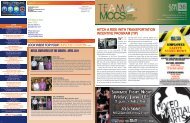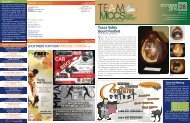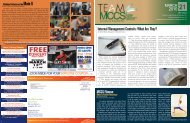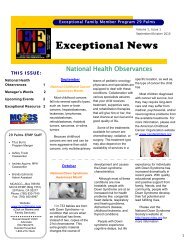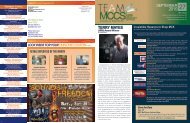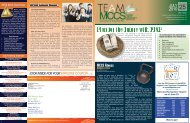Jan Team MCCS in read right order-8 - MCCS 29 Community Services
Jan Team MCCS in read right order-8 - MCCS 29 Community Services
Jan Team MCCS in read right order-8 - MCCS 29 Community Services
Create successful ePaper yourself
Turn your PDF publications into a flip-book with our unique Google optimized e-Paper software.
F<strong>in</strong>d Freedom from Domestic Violence<br />
Domestic violence is an epidemic <strong>in</strong> our society. In fact, one <strong>in</strong><br />
every four women will experience domestic violence <strong>in</strong> her lifetime.<br />
An estimated 1.3 million women are victims of physical assault by<br />
an <strong>in</strong>timate partner each year. Historically, females have been most<br />
often victimized by someone they know. Females between the<br />
ages of 20 and 24 are at a greater risk of non-fatal <strong>in</strong>timate partner<br />
violence. Most cases of domestic violence are never reported to<br />
police.<br />
CHILD VICTIMS<br />
Children who witness violence between parents/caretakers are<br />
the strongest risk factor for transmitt<strong>in</strong>g violent behavior from one<br />
generation to the next. In fact, boys are twice as likely to abuse their<br />
own partners and children when they become adults. Thirty to 60<br />
percent of perpetrators of <strong>in</strong>timate partner violence will also abuse<br />
children <strong>in</strong> the household.<br />
HOMICIDE AND INJURY<br />
Almost one <strong>in</strong> every three of female homicide victims that are<br />
reported <strong>in</strong> police records are killed by an <strong>in</strong>timate partner. In 70 to<br />
80 percent of <strong>in</strong>timate partner homicides, no matter which partner<br />
was killed, the man physically abused the woman before the murder.<br />
ECONOMIC IMPACT<br />
Intimate partner violence results <strong>in</strong> more than 18.5 million mental<br />
health visits each year. The cost of <strong>in</strong>timate partner violence<br />
exceeds $5.8 billion each year; approximately $4.1 billion of which<br />
is for direct medical and mental health services. There are 16,000<br />
homicides and $2.2 million (medically treated) <strong>in</strong>juries due to<br />
<strong>in</strong>timate partner violence annually which costs $37 billion.<br />
These facts may be grim, but you don’t need to become just<br />
another statistic. Choose to live free from domestic violence. If<br />
you are a victim of domestic violence, <strong>MCCS</strong> is here to help. The<br />
Family Advocacy Program offers counsel<strong>in</strong>g services, <strong>in</strong>tervention<br />
programs, victim advocates and more. Our staff is available to help<br />
you break free from the cycle of domestic violence.<br />
FOR HELP CALL:<br />
Family advocacy program, counsel<strong>in</strong>g services-760.830.6345<br />
24 hr. victim advocate- 760.830.4314<br />
BLDG. 1438, Door #1<br />
*sources – National Coalition Aga<strong>in</strong>st Domestic Violence<br />
Influenza<br />
Flu season is upon us. One of the best precautions for avoid<strong>in</strong>g this<br />
year’s bug is to be <strong>in</strong>formed. Our Q & A will better prepare you for<br />
protect<strong>in</strong>g yourself aga<strong>in</strong>st <strong>in</strong>fluenza.<br />
What Is Influenza?<br />
Influenza, also known as the flu, is a contagious disease that is<br />
caused by the <strong>in</strong>fluenza virus. It attacks the respiratory tract <strong>in</strong><br />
humans (nose, throat and lungs). Influenza usually comes on suddenly<br />
and may <strong>in</strong>clude such symptoms as fever, headache, tiredness<br />
(can be extreme), dry cough, sore throat, nasal congestion and body<br />
aches.<br />
Why get a flu vacc<strong>in</strong>ation?<br />
Each year thousands of people die from seasonal <strong>in</strong>fluenza and even<br />
more require hospitalization. By gett<strong>in</strong>g vacc<strong>in</strong>ated, you can protect<br />
yourself from <strong>in</strong>fluenza and may also avoid sp<strong>read</strong><strong>in</strong>g <strong>in</strong>fluenza to<br />
others. It takes up to two weeks for protection to develop after the<br />
shot. Protection lasts about a year.<br />
Who needs the flu vacc<strong>in</strong>e?<br />
All people 6 months of age and older should get a flu vacc<strong>in</strong>e. Tell<br />
your health care provider if you have any severe allergies. Children<br />
who are gett<strong>in</strong>g the flu vacc<strong>in</strong>e for the first time need a booster shot<br />
<strong>in</strong> six weeks.<br />
What types of <strong>in</strong>fluenza vacc<strong>in</strong>e are available?<br />
1. Inactivated (killed) vacc<strong>in</strong>e, or the “flu shot” is given by <strong>in</strong>jection<br />
<strong>in</strong>to the muscle.<br />
2. Live, attenuated (weakened) <strong>in</strong>fluenza vacc<strong>in</strong>e is sprayed <strong>in</strong>to the<br />
nostrils.<br />
What can I do to avoid the flu?<br />
Protect yourself and those around you by practic<strong>in</strong>g proper hygiene.<br />
Always cough or sneeze <strong>in</strong>to a tissue or the crook of your elbow,<br />
never <strong>in</strong>to your hands. Wash your hands often and avoid putt<strong>in</strong>g<br />
them near your mouth or nose. Pick up a bottle of hand sanitizer<br />
at the Ma<strong>in</strong> Exchange for those times when soap and water isn’t<br />
immediately available. Fend off the flu this season and help keep our<br />
workplace healthy!<br />
5



